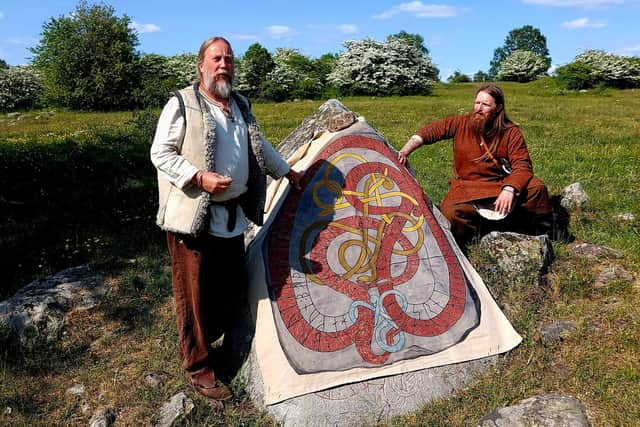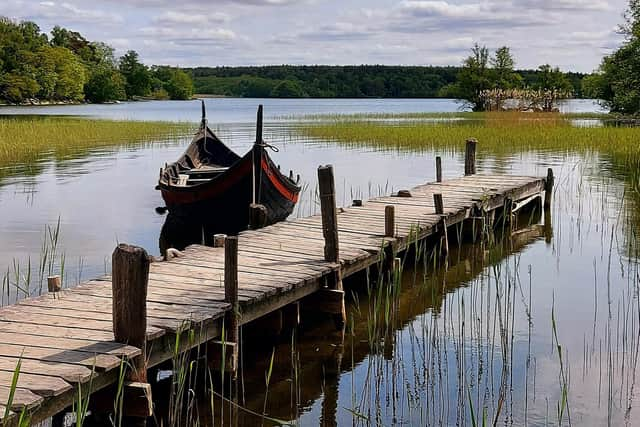A trip to Sweden helps Neil Geraghty find his inner Norseman… but why is he a tad queasy?
As I steady my wobbly knees I take in the view and the attention to detail is astonishing. On the far side of a meadow filled with willowherb lies the Viking settlement of Gamla Uppsala, widely considered to be the first capital of Sweden. For centuries this town of neatly constructed farmsteads, storage huts and longhouses played host to the Thing of all Swedes, a gathering of Viking chieftains held each spring. On this balmy summer morning, however, there’s barely a soul about, just a lone blacksmith rhythmically hammering out a piece of iron on an outdoor forge.
The VR journey back in time is a highlight of the Gamla Uppsala Museum which is built on the site of the ancient settlement. I’m tempted to climb the other burial mounds but in the absence of motion sickness tablets I call it a day, remove the headset and continue my exploration of this fascinating archaeological site at a more leisurely pace in the present day.
Advertisement
Hide AdAdvertisement
Hide AdIn the Middle Ages Uppsala moved five miles south and is now one of Sweden’s most beautiful cities. The Old Town is home to a magnificent medieval cathedral and the country’s most prestigious university, which imbues a languid academic charm over the cobbled streets.


During the 19th-century Uppsala University supported numerous archaeological excavations that helped ignite a worldwide fascination for Viking history that continues unabated to the present day. In front of the university I meet Jonathan Olsson, one of many authorised Viking guides in Sweden who lead history tours dressed in authentic costume. With his flowing beard and loose fitting linen trousers he looks every inch a Viking hipster but is quick to point out that a good appearance was highly prized in Viking society. Reaching into a leather purse, he pulls out a comb, toothpick and ear scoop, three essential accessories that no self-respecting Viking man would set sail without.
From Uppsala I head south towards Stockholm, stopping en route at Gunners Gård Open Air Museum where I’m just in time for lunch. The museum is a faithful reconstruction of a wealthy farmstead based on nearby archaeological remains discovered during road construction in the 1980s. The beautifully constructed wooden farm buildings with their distinctive crest of protruding beams ooze Scandinavian hygge and seem way ahead of their time for the Dark Ages. The food isn’t bad either.
On an outside fire a volunteer who resembles an extra from Lord of the Rings is baking unleavened bread on a long handled pan. I take a piece and help myself to a pot of barley stew which, mixed with aromatic parsnips, is surprisingly tasty and light on the stomach.
In Stockholm I check into the historic Hasselbacken Hotel which is located in the heart of Djurgården, a sleepy island covered in parkland where some of Stockholm’s finest museums are located. In front of the nearby Viking Museum a spirited sword fight is in full swing. Inside, engaging exhibits trace the fascinating mythology of the Vikings while a time capsule whisks visitors away on an epic voyage along the rivers of Russia to Constantinople where Harald, a hapless Viking ne’er-do-well, hopes to earn his fortune trading furs.


The following morning I embark on a delightful two-hour cruise through the Stockholm archipelago to the island of Birka, one of the Vikings’ most important trading towns and now a Unesco World Heritage site. Items from all over the known world have been excavated here including, most famously, a votive statuette of a Buddha from Kashmir. In 2017 the archaeological world was stunned when DNA analysis of a Viking warrior discovered in 1878 and long assumed to be male turned out to be female.
In Birka’s museum her face and the exquisite oriental silk fabrics she was wearing have been reconstructed and vividly illustrate the melting pot of cultural influences that permeated Viking society.
Surrounding Birka, the Vikings built over 2,500 burial mounds which are now covered in meadows and are ablaze with wildflowers in the summer. On top of one I sit down and take in the magnificent view of the islands of Lake Måleran. Many of the burial mounds remain unexcavated and as I listen to the skylarks twittering in the sky I wonder what other secrets the hills might reveal about this enigmatic and often misunderstood ancient culture.
For holiday ideas in Sweden visit www.visitsweden.comFor more information on Uppsala visit www.uppsala.se and the Viking Museum, www.thevikingmuseum.com